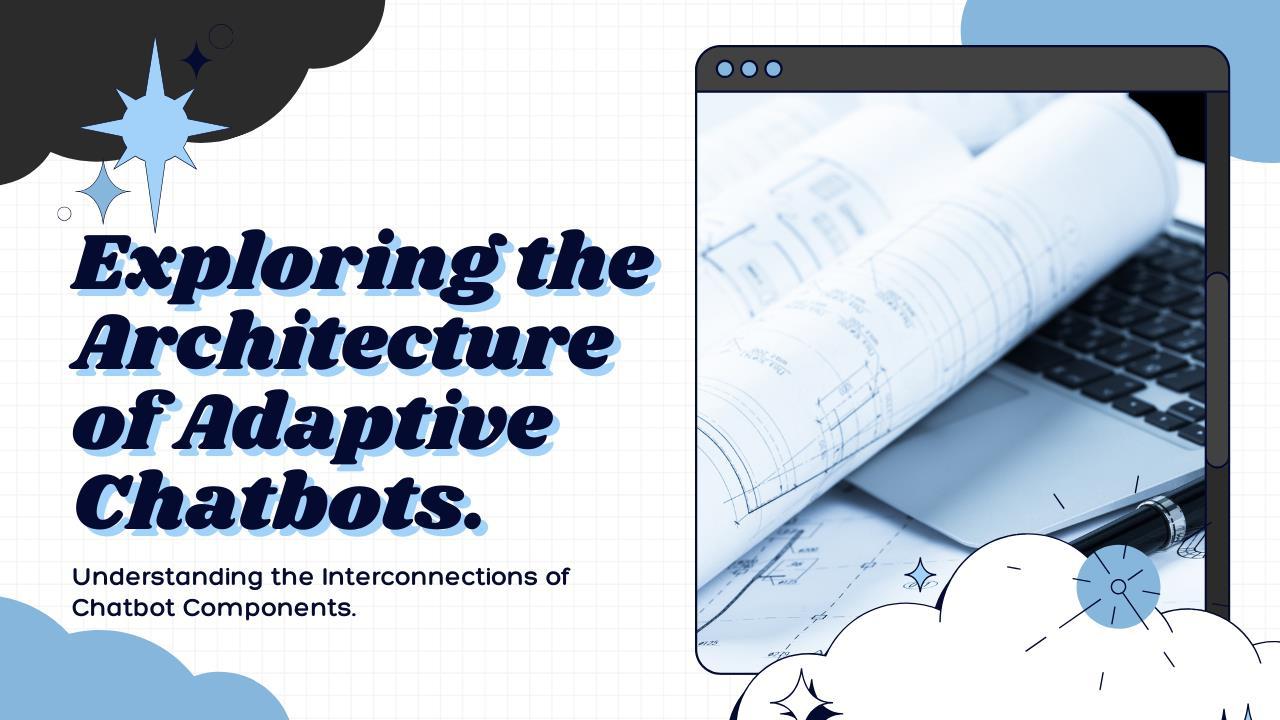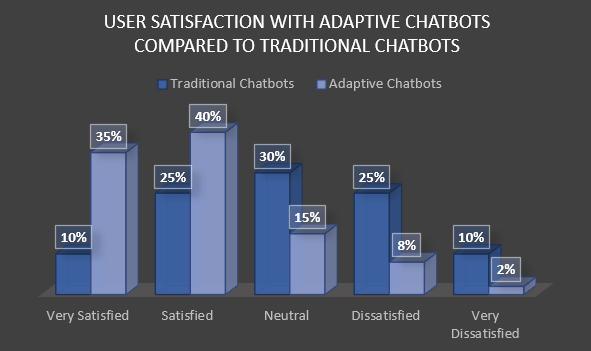
International Research Journal of Engineering and Technology (IRJET) e-ISSN:2395-0056
Volume: 11 Issue: 05 | May 2024 www.irjet.net
ADAPTIVE CHATBOTS: ENHANCING USER EXPERIENCE THROUGH INTERACTIVE LEARNING AND DYNAMIC RESPONSE REFINEMENT
Abhi Ram Reddy Salammagari*1, Gaurava Srivastava*2
247 Ai Inc., USA
Oracle America Inc., USA
ABSTRACT
The rapid advancement of artificial intelligence has propelled chatbots into a new era of interactive learning and adaptation. This article delves into the concepts, mechanisms, and applications of adaptive chatbots that utilize machine learningandnaturallanguageprocessingtoconstantlyimprovetheirresponsesthroughuserinteractions.Thepotentialof these technologies in personalized learning, customer service, and improving the user experience is emphasized by lookingatthemainpartsofadaptivechatbotsystemsandthelearningprocessthatmakesdynamicresponserefinement possible.Thearticledelvesintorecentadvancementsinmachinelearningalgorithms,naturallanguageprocessing,andthe riseofself-improvingchatbots.Inaddition,thechallengesrelatedtoprivacy,security,andthecomplexityofinterpreting humanlanguageandsentimentinthecontextofinteractivelearningandadaptationareaddressed.Finally,itisimportant tohighlighttheimportanceoffutureresearchanddevelopmentinfindingabalancebetweenautomationandhuman-like interactioninordertofullyunlockthepotentialofAI-drivenchatbots.
Keywords: AdaptiveChatbots,InteractiveLearning,NaturalLanguageProcessing,PersonalizedUserExperience,Machine LearningAlgorithms

INTRODUCTION
The rise of artificial intelligence (AI) has completely transformed the way chatbots engage with users, allowing them to constantly learn and adapt based on user interactions [1]. The interactive learning and adaptation approach has revolutionized chatbots, turning them into intelligent conversational agents that offer personalized and engaging user experiences [2]. Through the use of advanced machine learning algorithms and natural language processing (NLP) techniques, these adaptive chatbots can continuously improve their responses by incorporating user feedback and adapting to changing user requirements [3]. The applications of chatbots are wide-ranging, covering personalized education,customersupport,anduser experienceenhancement[4].Exploringthe concepts, mechanisms,advancements,

International Research Journal of Engineering and Technology (IRJET) e-ISSN:2395-0056
Volume: 11 Issue: 05 | May 2024 www.irjet.net p-ISSN:2395-0072
and challenges associated with interactive learning and adaptation in chatbots is essential as the demand for intelligent andadaptivechatbotscontinuestogrow[5].
Feature Traditional Rule-based Chatbots
Interaction style
Learning ability
Natural language understanding
Knowledge base
Fixed,predefinedresponses
Nolearningfromuserinput
Limited, pattern-matching based
Static,manuallyupdated
Personalization Limited, based on predefined rules
Flexibility
Low, restricted to predefined scenarios
Adaptive Chatbots
Dynamic,personalizedresponses
Continuous learning from user interactions
Advanced, context-aware and sentiment-sensitive
Expandable,automaticallyupdated
High, based on user preferences and behavior
High,adaptabletonewsituations
Table 1: Comparison of traditional rule-based chatbots and adaptive chatbots [74]
INTERACTIVE LEARNING AND ADAPTATION: CONCEPTS AND MECHANISMS
Defining interactive learning and adaptation in chatbots
Interactive learning and adaptation in chatbots involve AI-driven conversational agents continuously improving their responses based on user interactions [6]. The dynamic learning process empowers chatbots to enhance their comprehension of user intent, preferences, and context, resulting in more precise and personalized responses as they progress [7]. Through the use of machine learning algorithms and natural language processing techniques, adaptive chatbotshavetheabilitytoindependentlyupdatetheirknowledgebaseandconversationstrategieswithouttheneedfor explicitprogramming[8].
Key components of adaptive chatbot systems
Adaptive chatbot systems comprise various essential components that collaborate to enable interactive learning and adaptation. The components mentioned consist of natural language processing, machine learning algorithms, and user feedbackandinteractiondata[9].
Natural language processing
Naturallanguageprocessing(NLP)playsavitalroleinadaptivechatbotsystems,allowingthemtocomprehend,interpret, andproducehumanlanguage[10].Chatbotscangetusefulinformationfromuserinputandrespondinawaythatmakes sense by using NLP techniques like named entity recognition, part-of-speech tagging, and tokenization [11]. Utilizing advanced NLP techniques, like sentiment analysis and contextual embedding, significantly improves chatbots' comprehensionofuserintentandemotion,resultinginmoreauthenticandcaptivatingconversations[12].
Machine learning algorithms
Machine learning algorithms are essential for adaptive chatbot systems, allowing them to enhance their performance throughuserinteractions[13].Supervisedlearningalgorithms,likedecisiontreesandneuralnetworks,havetheabilityto be trained on labeled conversation data. This allows them to classify user intent and generate suitable responses [14]. Unsupervised learning algorithms, like clustering and dimensionality reduction, aid chatbots in uncovering patterns and relationships in user data, enabling the creation of highly customized content [15]. Reinforcement learning algorithms facilitate chatbots in acquiring optimal conversation strategies by utilizing trial and error, user feedback, and rewards [16].

International Research Journal of Engineering and Technology (IRJET) e-ISSN:2395-0056
Volume: 11 Issue: 05 | May 2024 www.irjet.net p-ISSN:2395-0072
User feedback and interaction data
Feedback and interaction data are crucial for the interactive learning and adaptation process of chatbots [17]. Feedback from users, like ratings and comments, offers valuable insights into the quality and relevance of chatbot responses. This helps developers identify areas for improvement [18]. Utilizing implicit feedback, such as user engagement metrics and conversation flow analysis, can assist chatbots in adjusting their strategies to better cater to user needs and preferences [19]. Through continuous collection and analysis of user feedback and interaction data, adaptive chatbots can enhance theirperformanceanddelivermoreengagingandsatisfyinguserexperiences[20].
Thelearningprocess:Fromuserinputtoadaptiveresponses
The learning process in adaptive chatbots entails a continuous cycle of user input, data processing, response generation, and performance optimization [21]. When a user interacts with the chatbot, the NLP component initially processes the input to extract pertinent features and comprehend the message's intent [22]. The information is then fed into the machine learning algorithms, which generate an appropriate response based on the learned patterns and conversation strategies[23].Thegeneratedresponseispresentedtotheuser,andtheirfeedbackandinteractiondataarecollectedand storedforfutureanalysis[24].Themachinelearningalgorithmsthenutilizethisdatatoupdatetheirmodelsandenhance theirperformance,allowingthechatbottodelivermorepreciseandtailoredresponsesinfutureinteractions[25].
APPLICATIONS OF ADAPTIVE CHATBOTS
Personalized education and tutoring
Adaptivechatbotshavebeenwidelyusedinpersonalizededucationandtutoring.Throughtheuseofinteractivelearning andadaptation,chatbotshavetheabilitytoofferpersonalizededucationalexperiencestostudents,resultinginenhanced learningoutcomesandincreasedengagement[26].
Adapting teaching strategies based on student performance
Adaptive chatbots possess the capability to analyze student performance data, such as quiz scores and engagement metrics,todynamicallymodifytheirteachingstrategies[27].Forinstance,ifastudentconsistentlyfaceschallengeswith a specific concept, the chatbot can provide additional explanations, examples, or resources to enhance the student's understandingofthematerial.However,whenastudentdemonstratesasolidgraspofatopic,thechatbotcanmoveonto moreadvancedconceptsorprovideextraactivities[28].
Providing individualized feedback and support
Feedback and support tailored to individual needs are essential for effective learning. Adaptive chatbots offer real-time, personalized feedback on student assignments, assisting in identifying areas for improvement and providing targeted suggestions [29]. In addition, chatbots have the ability to provide emotional support and motivation, tailoring their communicationstyletocatertotheuniqueneedsandpreferencesofeachstudent[30].
Customersupportandservice
Adaptivechatbotshaverevolutionizedcustomersupportandservicebyprovidingefficientandpersonalizedassistanceto users. By analyzing customer interactions, chatbots can consistently improve their performance and deliver exceptional supportexperiences[31].
Learning from customer queries to improve solution accuracy
Adaptive chatbots have the ability to analyze customer queries and feedback to identify common issues, questions, and preferences. By analyzing this data, chatbots can enhance their knowledge base and enhance the accuracy of their solutionsovertime[32].Thegoalistoconsistentlyprovidecustomerswiththemostrelevantandup-to-dateinformation, while actively engaging in a continuous learning process. This approach decreases the need for human intervention and enhancestheoverallefficiencyofsupport[33].
Personalizing responses to enhance customer satisfaction
Enhancing customer satisfaction in support interactions is achieved by customizing the experience to each individual. Adaptivechatbotshavetheabilitytocustomizetheirresponsesbytakingintoaccountcustomerprofiles,preferences,and

International Research Journal of Engineering and Technology (IRJET) e-ISSN:2395-0056
Volume: 11 Issue: 05 | May 2024 www.irjet.net p-ISSN:2395-0072
interaction history. Utilizing personalized recommendations, offers, and communication styles, these chatbots have the potentialtoenhancesupportexperiences,ultimatelyfosteringgreatercustomerloyaltyandretentionrates[35].
User experience enhancement
Adaptivechatbotsareessentialforimprovinguserexperiencesondifferentdigitalplatforms.Throughtheanalysisofuser interactionsandpreferences,chatbotshavetheabilitytoenhanceexperiences,resultingingreaterengagement,efficiency, andpersonalization[36].

Tailoring interactions based on user preferences and behavior
Adaptive chatbots have the ability to analyze user behavior data, including browsing history, search queries, and interaction patterns, in order to gain valuable insights into individual user preferences and interests [37]. Utilizing this information, chatbots can tailor their interactions, recommendations, and content to better meet the needs and expectationsofeachuser[38].
Creating
more engaging and efficient digital assistants
Adaptive chatbots have the ability to function as effective digital assistants, aiding users in navigating intricate digital environmentsandaccomplishingtaskswithgreaterefficiency[39].Throughlearningfromuserinteractionsandfeedback, chatbots can consistently improve their performance, offering increasingly accurate and contextually relevant assistance [40].Theadaptabilityofthissystemresultsinenhanceduserexperiences,ultimatelyreducingcognitiveloadandboosting usersatisfaction[41].
ADVANCEMENTS IN INTERACTIVE LEARNING AND ADAPTATION
Developments in machine learning algorithms
Advancementsinmachinelearningalgorithmshavesignificantlyenhancedinteractivelearningandadaptationinchatbots. Deeplearningtechniquesandreinforcementlearninghavebeenshowntobeeffectiveinenhancingtheperformanceand adaptabilityofconversationalagents[42].
Deep learning techniques for natural language understanding
Convolutional neural networks (CNNs) and recurrent neural networks (RNNs) have significantly influenced natural languageunderstandinginchatbots[43].Byutilizingthesetechniques,chatbotsareabletoacquireadeepunderstanding of user intent, context, and sentiment through the analysis of extensive conversational data [44]. Transformer-based models such as BERT have demonstrated remarkable performance in a wide range of natural language understanding tasks,significantlyimprovingtheaccuracyandfluencyofchatbotresponses[45].
© 2024, IRJET | Impact Factor value: 8.226 | ISO 9001:2008 Certified Journal | Page2085

International Research Journal of Engineering and Technology (IRJET) e-ISSN:2395-0056
Volume: 11 Issue: 05 | May 2024 www.irjet.net p-ISSN:2395-0072
Reinforcement learning for optimizing chatbot strategies
Reinforcement learning (RL) is widely recognized as a promising approach to optimize chatbot strategies and improve theiradaptability[46].InRL-basedchatbots,theagentlearnstotakeactions(generateresponses)thatmaximizeareward signal, such as user satisfaction or task completion. By continuously learning from user feedback and interactions, RLbased chatbots can autonomously refine their conversation strategies and adapt to user preferences [47]. This approach has demonstrated its effectiveness in various domains, such as customer support and personalized recommendations, leadingtomoreengagingandefficientchatbotinteractions[48].
Advancements in natural language processing
Advancements in natural language processing (NLP) have greatly enhanced the ability of chatbots to understand and generate conversations that mimic human interaction. Contextual understanding, sentiment analysis, and multilingual adaptabilityarekeyareasofemphasisinNLPresearch[49].
Contextual understanding and sentiment analysis
Understanding the context and analyzing sentiment are crucial for chatbots to engage in more natural and empathetic conversations. Advancements in NLP, such as context-aware word embeddings and attention mechanisms, have greatly improved chatbots' ability to capture and maintain context throughout conversations [50]. Furthermore, the implementation of sentiment analysis techniques such as aspect-based sentiment analysis and emotion recognition has enabled chatbots to effectively identify and address user emotions, leading to more personalized and empathetic interactions.
Multilingual and cross-lingual adaptability
Adaptability to multiple languages and cultures is essential when developing chatbots for global audiences. Advances in cross-lingual wordembeddingsandmachinetranslation haveenabledchatbotstounderstandandgenerate responsesin multiple languages [52]. Transfer learning techniques have also been used to adapt chatbots trained in one language to another, thus reducing the need for extensive language-specific training data [53]. The advancements in chatbot technology have opened up new possibilities for creating inclusive and accessible interactions that cater to the needs of diverseuserpopulations.
The rise of self-improving chatbots
Autonomous chatbots that can expand their knowledge base and refine their interaction strategies have garnered considerable attention in recent years. These chatbots utilize sophisticated machine learning techniques to constantly learnandadaptwithouttheneedfordirecthumaninvolvement[54].
Autonomous knowledge base expansion
Autonomous knowledge base expansion stands out as a crucial feature of self-improving chatbots. Through the use of informationextractionandknowledgegraphconstructiontechniques,chatbotshavetheabilitytoacquirenewknowledge from a variety of sources, including web pages, databases, and user interactions [55]. Continuous knowledge acquisition allowschatbotstoofferinformativeandcurrentresponses,adjustingtothechangingneedsandinterestsofusers[56].
Continuous refinement of interaction strategies
Chatbots that can continuously refine their interaction strategies based on user feedback and engagement metrics are highly effective in improving their performance. Through the utilization of techniques like online learning and active learning, chatbots have the ability to independently enhance their conversation flows, response generation, and personalization strategies [57]. The continuous refinement of chatbots leads to more engaging and efficient interactions, as they learn to adapt to individual user preferences and communication styles [58]. The emergence of self-improving chatbots represents a noteworthy achievement in the advancement of fully autonomous and adaptable conversational agents.

International Research Journal of Engineering and Technology (IRJET) e-ISSN:2395-0056
Volume: 11 Issue: 05 | May 2024 www.irjet.net p-ISSN:2395-0072
CHALLENGES AND FUTURE DIRECTIONS
Challenge
Privacy and security concerns
Complexity of human language understanding
Robust unsupervised learning mechanisms
Balancing automation and humanlike interaction
Ethical considerations and bias mitigation
Potential Solutions
Secure data management practices and privacy-preserving learningalgorithms
Advanced context-aware and emotion-sensitive language models
Integration of reinforcement learning with safety constraints andself-monitoringtechniques
Adaptive conversation strategies based on user preferences andinteractioncontext
Incorporation of value alignment techniques and explainable AImethods
Table 2: Challenges and potential solutions in the development of adaptive chatbots [75]
Privacy and security concerns in user data handling
Adaptive chatbots heavily rely on user data for learning and personalization, making privacy and security concerns increasinglyimportant.Ensuringthesafehandlingandstorageofsensitiveuserinformation,suchaspersonalpreferences, conversationhistory,andauthenticationdetails,isacrucialchallenge[59].Developingsecuredatamanagementpractices, suchasimplementingdataencryption,accesscontrolmeasures,andanonymizationtechniques,iscrucialformaintaining user trust and adhering to privacy regulations [60]. Future research should prioritize the development of privacypreservinglearningalgorithmsandsecuredatasharingprotocolstoeffectivelyaddresstheseconcerns[61].
Complexity of accurately interpreting human language and sentiment
Accurately interpreting human language and sentiment continues to be a complex challenge, despite significant advancements in natural language processing. Handling ambiguity, sarcasm, metaphors, and contextual dependencies in userutterancesnecessitatesadvancedlanguageunderstandingmodels [62].Inaddition,capturingandrespondingtothe subtle nuances of human emotion and sentiment adds another layer of complexity to chatbot development [63]. To address these challenges, it is crucial to enhance context-aware and emotion-sensitive language models, while also integratingcommonsensereasoningcapabilities[64].
Developing robust mechanisms for unsupervised continuous learning
Enabling chatbots to learn continuously from user interactions without explicit human supervision poses a significant challenge. Unsupervised learning algorithms need to be able to handle noisy and inconsistent user feedback and avoid learning undesirable behaviors [65]. Establishing robust methods for detecting anomalies, correcting errors, and mitigating biases is essential to maintain the stability and efficacy of unsupervised learning in chatbots [66]. Future researchshouldinvestigatetheintegrationofreinforcementlearningwithsafetyconstraintsandthedevelopmentofselfmonitoringtechniquesforautonomouslearningsystems[67].
Balancing automation and human-like interaction
Finding the perfectequilibriumbetweenautomationanda conversational approach posesa significanthurdleinchatbot design.Automationplaysacrucialroleinachievingefficiencyand scalability.However,itisequallyimportanttoensurea naturalandengagingconversationflowtokeepuserssatisfied[68].Placingtoomuchemphasisonautomationcanresult ininteractionsthatfeelrigidandimpersonal.Ontheotherhand,iftoomuchattentionisgiventohuman-likeresponses,it mayaffectthechatbot'sperformanceandconsistency[69].Optimizingthebalancebetweenthesetwoaspectsnecessitates thoughtfulexaminationofuserexpectations,taskcomplexity,andtheconstraintsofcurrenttechnologies.Futureresearch should explore adaptive conversation strategies that can dynamically adjust the level of automation based on user preferencesandthecontextoftheinteraction[70].


